The Crush
Ask a winemaker about their favorite date on the wine calendar. Assuredly, Crush Day is the answer. Year-long vineyard thought and hard work have led to this critical milestone. Having come full cycle, wine creation begins anew with a new vintage. Excitement is in the air, a party may be in the works. But first, the crush. The crush is an all-encompassing term covering the harvest and preparing grapes for the next winemaking process phase, pressing and fermenting.
Unless you have your own vines, there are a couple of approaches to sourcing fresh grapes. Finding and working with a local grape grower is preferred. The benefit of interacting with the grower, enabling you to discover and possibly have some control over the state and quality of the grapes, can’t be underestimated.
If access to a local grower is not feasible, the approach a greater majority of home winemakers pursue involves ordering grapes from a local winemaking retailer. A local retailer has the capability of ordering grapes in bulk from a produce wholesaler or grape grower.
While sourcing fresh fruit is seasonally tied to a harvest, another option involves procuring frozen grapes. They can also be ordered through a local winemaking retailer or from a producer found online during all times of the year.
The next step involves breaking down the harvested grape clusters via crushing (breaking the grape skins) and destemming (removing the stems). The result is must, which is then pressed and fermented during the next winemaking phase. Specialized equipment is preferably required for crushing/destemming. Since the equipment is a significant investment, renting a Crusher Destemmer may be possible through a local winemaking retailer. Plus, you can explore additional techniques for crushing/destemming.
There are subtle more advanced variations to crushing/destemming, employed by commercial and home winemakers alike. In particular, skipping the crush, and conducting a “whole cluster” press. This approach is used when a winemaker seeks certain desired flavor profiles specific to a grape varietal. Another variation involves removing all stems and decoupling the grape clusters, pressing and fermenting just the grapes.
Pressing and fermentation is the next step of the winemaking process, which can begin the same day or within a few days of the crush. Testing to affirm the Brix (sugar level), pH (acidity) and the TA to inform “the state” of the must or juice (sugar and acidity for example) are also conducted right after the crush. Find additional information about testing on the Testing topic block page.
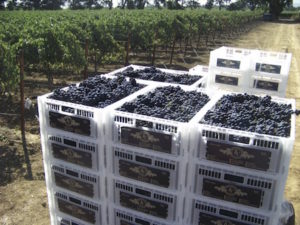
Fresh Grape Packing Action for the Nation’s Home Winemakers (Lodi Wine)
Every mid-September through early October, one of the common sights in vineyards in Lodi is pickers loading grapes into 40-pound lug boxes. Next to the vines, the pickers weigh each lug box on scales in order to be as precise as possible. At the edge of the vineyards, on the side of the road, the lugs are then emptied into colorful wooden boxes by grape packers.
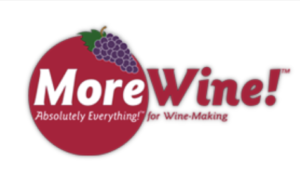
Testing the Must for Sugar Content, pH and TA (MoreWine!)
Before you add the yeast, you need to test the must to determine if any additions/corrections are needed. Very rarely will you get a grape that naturally has the required balance of acids, sugars, and pH necessary to create a harmonious wine. When one or more of these elements are out of their ideal ranges, the quality of the wine suffers.
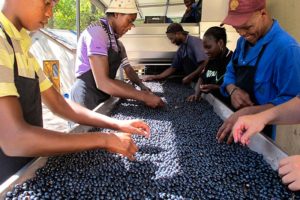
Harvest 101: The Basics of Crush Season (Wine Spectator)
Sports teams have playoffs. Students have finals. And for winegrowers, the big sink-or-swim moment—the event the whole year’s efforts have led up to—is harvest. The period culminating in grape crush begins when the grapes start to change color in mid to late summer. The actual picking of the grapes usually happens between August and November above the equator and February to April below.
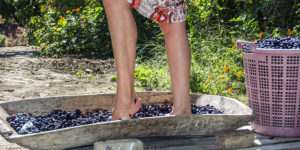
The Crush is the First Step in Turning Grapes into Wine (VinePair)
Foot treading is anything but the homey, silly dance most drinkers imagine when they think of traditional grape-stomping rituals. In reality, foot treading is far more work than modern methods for crushing grapes, though it starts the winemaking process off as efficiently as more advanced and modern methods.
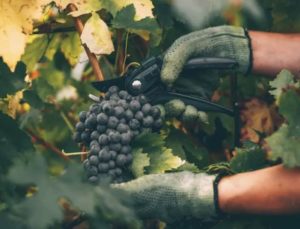
How to Harvest Quality Fruit (Western Agricultural Research Center – MSU)
Aim for harvesting on a cool, dry day, as dry grapes will store longer than wet grapes. There are a couple different harvesting tools to choose from. One option is to use sharp pruning shears/clippers (we prefer the more scissor-like trimmers with narrow tips) rather than pulling clusters by hand, as this will ensure you’re not damaging the vine or knocking off other clusters.
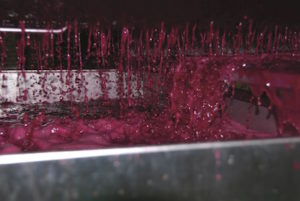
How To Crush Grapes And Why It’s Important! (AIH)
Crushing the wine grapes is a very straight forward process. All you do is burst the skin of each grape. This is necessary to release the juice. It also allows the yeast and enzymes into the grape to further break down the fiber and release even more juice along with flavor and body elements that will make up the character of the resulting wine.
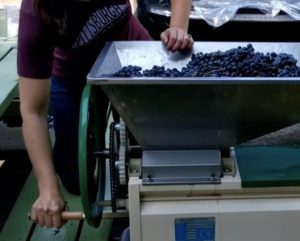
Using a Grape Crusher Destemmer (The Home Winemaking Channel)
This is a Marchisio Manual Crusher Destemmer with a stainless hopper and grate. The grapes that we are running through it are old vine zinfandel from Lodi, California. The crusher destemmer has a mount for a motor but for anything under 500lbs it would not be necessary.
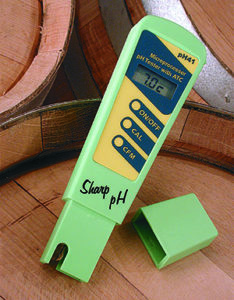
Monitoring and Adjusting pH (WineMaker)
I am always surprised at how many winemakers — new and experienced alike — still make wine with absolutely no concern for pH. It’s akin to never checking the engine oil in your car. Sooner or later, you’ll be left stranded by the side of the road, hood open, and smoke billowing from the engine . . . or with a case of spoiled wine.

